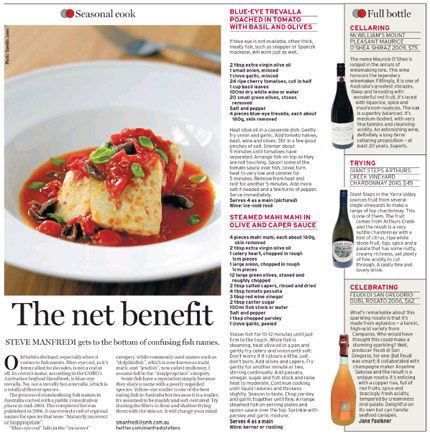
SEASONAL COOK: FISH NAMES
Old habits die hard. And, when it comes to fish names, they just won’t go away!
Blue-eye cod- as it’s been called for decades- is not a cod at all. Its correct name, according to the CSIRO’s Australian Seafood Handbook is blue-eye trevalla. No, not a trevally but a trevalla, which is a totally different species.
CSIRO Marine Research, Fisheries Research and Development Corporation, and Seafood Services Australia began a process of standardising fish names with a public consultation phase in mid-2004 and the finished list was published in 2006. What was uncovered was a raft of regional names for species that were “blatantly incorrect or inappropriate”.
“Blue-eye cod” would be deemed incorrect. In the “inappropriate” category I would assume were common-use names such as “dolphinfish”, which is now known as mahi mahi, and “jewfish”, now called mulloway. Both these last two fish are highly prized and great quality.
Some fish simply have a reputation simply because they share a species name that is poorly thought of. Yelloweye mullet is one of the best eating fish in Australia but because it is a mullet it’s assumed to be muddy and soft-textured. Try dusting the fillets in flour and shallow frying, skin on. It’ll change your mind about this mullet.
twitter.com/manfredistefano
BLUE-EYE TREVALLA POACHED IN TOMATO WITH BASIL AND OLIVES
If blue eye is not available, other thick, meaty fish such as snapper or Spanish mackerel will work just as well.
Heat olive oil in a casserole and gently fry onion and garlic until soft and fragrant. Add tomato halves, basil, wine and olives and stir in a couple of good pinches of salt. Simmer till tomatoes have fallen apart- about 5 minutes. Arrange fish pieces on top so they are not touching each other. Spoon some of the tomato sauce over fish, turn heat to very low and place lid on casserole. Simmer, covered, for 5 minutes then take off heat and rest for another 5 minutes. Add more salt if needed and a few good turns of pepper. Serve immediately.
Serves 4 as main.
Wine: Ice-cold rosé
STEAMED MAHI MAHI IN OLIVE AND CAPER SAUCE
Place fish pieces in a steamer and steam for 10-12 minutes, depending on thickness. Fish should be just firm to the touch. While fish are steaming, heat olive oil in a pan and gently fry celery and onion till soft. Don’t worry if they colour a little, just don’t burn. Add chopped olives and rinsed capers and gently fry for a minute or two more, continually stirring. Add passata, vinegar, sugar and fish stock and turn up heat to moderate. Keep cooking until liquid reduces and thickens a little. Season to taste with salt and pepper. Chop parsley and garlic together till fine. Arrange steamed fish on serving plates and spoon sauce over the top. Finish by sprinkling with parsley/garlic mixture.
Serves 4 as a main course.
Wine: Kerner or Riesling